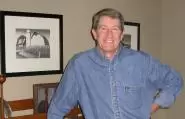Knocking Down Brick Walls – With One Finger

William Faulkner once said, “Writing is easy. Rewriting is when the work begins.”
What he forgot to mention was the best part of writing: the research.
Research is fun. And let me tell you a secret: the more you research, the easier writing becomes.
I know a lot of people who want to be writers. When I was just 26 I wanted to write the Great American Novel. The only person who even came close at that age was F. Scott Fitzgerald, who wrote This Side of Paradise before he was 24. Turns out it wasn’t the Great American Novel and Fitzgerald spent the rest of his brief, tragic life, including two lonely, desperate years in Asheville, trying to recapture those magical eight weeks he spent writing it.
It took me until I was 26-and-a-half to determine that I hadn’t lived enough to write a Great Mediocre Novel, let alone the Great American Novel. But I still wanted to be a writer.
And so I did what seemed natural. I wrote non-fiction.
I worked for both a weekly and a daily newspaper, writing new stories, feature articles, business profiles, sports stories, school board reports, even obituaries. I wrote study guides, magazine articles, and both newspaper and magazine columns.
And the more I researched, the easier the writing became.
Research used to be expensive and time-consuming. Either you bought expensive books or you spent countless, unpaid hours in a university library. But the internet changed all of that. Now with just a quick Google search you can open more doors – and travel down more hidden passageways – in just a few minutes time than you could in an entire month.
A few weeks ago I became interested in two Boston Arts & Crafts silversmiths, Karl Leinonen and Mary Knight. I had known both of their names and their shopmarks from my research last year for my book Arts & Crafts Shopmarks: 1890-1940, but had paid little attention to them or their work.
But after seeing pictures of a couple of examples of their work, I became curious. With just a couple of clicks on my keyboard I discovered that at age 27 Mary Catherine Knight had been accepted onto the staff at the Handicrafts Shop run by the Arts & Crafts Society of Boston. She was assigned a spot at a workbench near that of the shop foreman, 32-year-old Karl Leinonen, who had emigrated to the United States from Finland. Not only did Leinonen teach Knight how he had mastered the craft of raising a bowl from a flat sheet of silver, but the student taught the master how the tools of a leathercrafter could be utilized to embellish portions of the silver with delicate, intricate designs.
Each tidbit of information raised more questions, and when I could not find the answers online, the internet provided another option. In my case I needed to find an article in the April 1907 edition of Keramic Studio, which I had heard of, but had never seen. Fifteen years ago I would have hit a brick wall. Last week, however, I was able to send an email off to a half dozen friends, and within a few hours they had all responded. Three didn’t know of a source, but had suggestions; one knew a library that had copies of Keramic Studio, and two sent me scanned copies of the article I needed.
Just like that.
The brick wall crumbled and I walked on through.
The point I want to make is simple. As much as we know about Gustav Stickley and Elbert Hubbard, Frank Lloyd Wright and Charles Sumner Greene, there are a hundred Mary Knights and Karl Leinonens, waiting for someone to do a few searches, to click a few keys on the keyboard.
As we collectors unearth more discoveries, we need more knowledge. While Stickley and Hubbard are important, we need to know more about the Mary Knights and the Karl Leinonens. And today it is easier than ever before.
You may have heard me from atop my soapbox once or twice before, but it bears repeating. If we would each take just one name, one person, one Mary Knight, or one Karl Leinonen, a George Arthur, Seth Elk, Esther Elliott, Cecil Duell, Bjarne Axness, Digby Brooks or Henry Cushman and find out everything we can about them, we could assemble a fantastic database of information that would expand the entire world of Arts & Crafts collecting.
And with enough research, the writing is really easy.

Until next Monday,
Who could be your Mary Catherine Knight?
– Bruce
